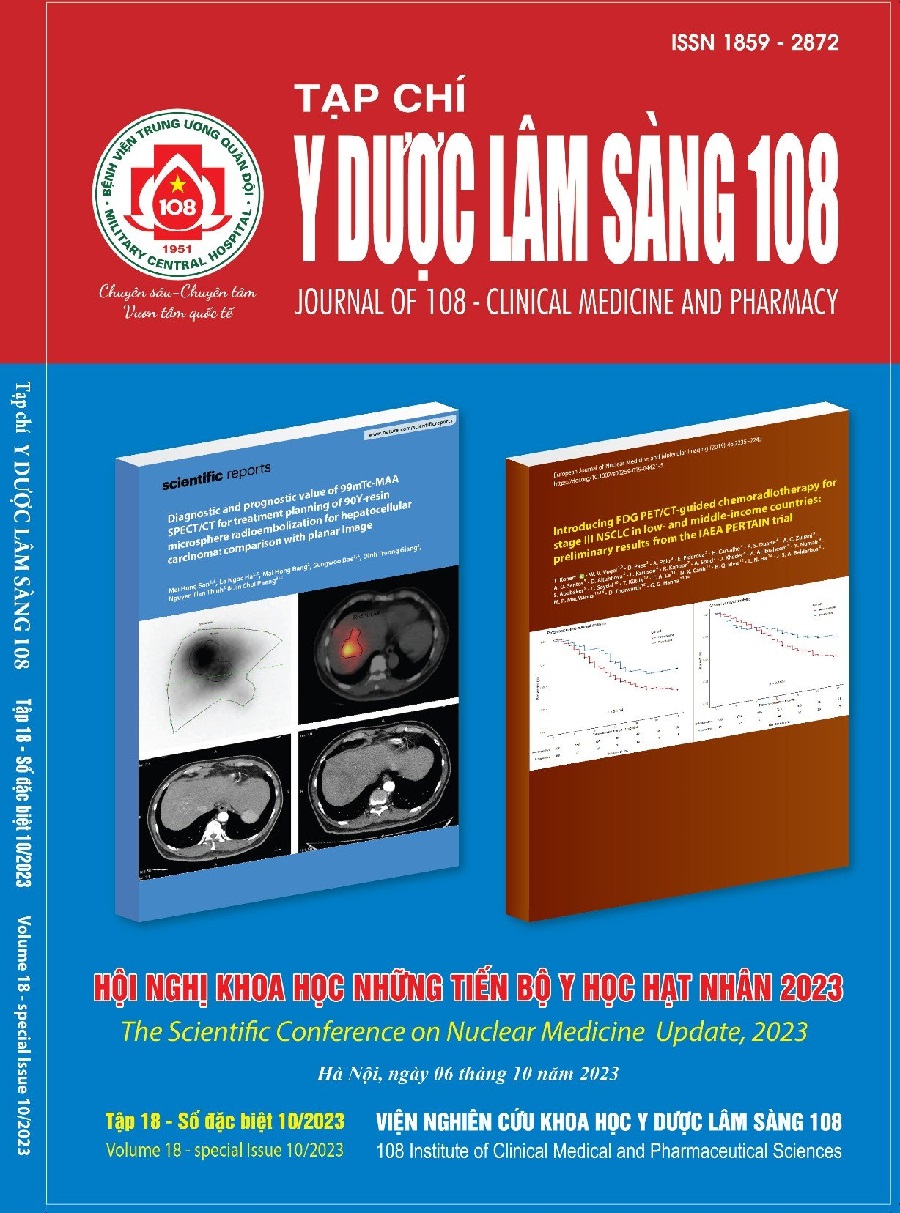A comparison between cytological diagnosis according to the 2018 Bethesda classification and histopathology of thyroid carcinoma at 108 Military Central Hospital
Main Article Content
Keywords
Abstract
Objective: To compare the cytological diagnosis according to the 2018 Bethesda classification with the histopathology of thyroid carcinoma at 108 Military Central Hospital. Subject and method: 529 cases were diagnosed with preoperative cytology and post-operative histopathological results at 108 Military Central Hospital as thyroid carcinoma from January 2020 to April 2021. The cytological diagnosis was according to the 2018 Bethesda system for reporting thyroid cytopathology. The histopathological classification was according to the 2017 World Health Organization classification of thyroid neoplasms. Result: The rate of thyroid carcinoma in females/males was 4/1. The tumor was common in the right lobe (42.9%) and rare in the isthmus (6.4%), with the average tumor size being 1.1 ± 0.9cm and 66.2% of the cases were less than 1cm. The diagnosis of thyroid carcinoma was mainly found in the groups of Bethesda V and VI, with 47.1% and 29.6% of the cases, respectively. The Bethesda I group with tumor size < 0.5cm accounted for the highest proportion, with 55.6% of the tumors, and the Bethesda II group with ≥ 2 neoplasms had a rate of 63.6%. The diagnosis of papillary thyroid carcinoma was more common in group V (48.5%), followed by group VI (30.1%), while the number of follicular thyroid carcinoma in group IV was the highest (53.8%). None of the follicular carcinoma belongs to groups II and VI. Cytological classification with small-size tumors tend to be higher in a malignant group compared with tumor groups with larger sizes. Conclusion: The cytological diagnosis of thyroid carcinoma was found mainly in groups V and VI, with the papillary being the most common type. The follicular thyroid carcinoma, on the other hand, was commonly found in group IV. Cytological classification for thyroid gland in a benign and malignant group has statistically significant differentiation in tumor sizes.
Article Details
References
2. Nguyễn Thị Thanh Yên (2019) Đối chiếu kết quả siêu âm, mô bệnh học với mô bệnh học ung thư biểu mô tuyến giáp tại Bệnh viện Ung bướu Hà Nội. Luận văn thạc sỹ y học, Đại học Y Hà Nội.
3. Kabbash MM (2019) The prevalence of thyroid cancer in patients with multinodular goiter. The Egyptian Journal of Hospital Medicine 77(6): 5906-5910.
4. Cibas ES, Ali SZ (2017) The 2017 bethesda system for reporting thyroid cytopathology. Thyroid 27: 1341-1346.
5. Haugen BR, Alexander EK, Bible KC et al (2016) American Thyroid Association management guidelines for adult patients with thyroid nodules and differentiated thyroid cancer: The American Thyroid Association Guidelines Task Force on Thyroid Nodules and Differentiated Thyroid Cancer. Thyroid 26: 1-133.
6. Kadam PN, Nafela AS, Deepak SS (2017) Evaluation of Bethesda system for reporting thyroid cytology with histopathological correlation. Journal of Medical Science and Clinial Research 01: 573-580.
7. Lloyd R, Osamura R, Kloppel G, Rosai J (2017) WHO classification of tumours of endocrine organs, 4th edn. (International Agency for Research on Cancer, Lyon, France, 2017).
8. Mistry SG, Mani N, Murthy P (2011) Investigating the value of fine needle aspiration cytology in thyroid cancer. Journal of Cytology/Indian Academy of Cytologists 28(4): 185.
9. Renshaw AA (2012) Histologic follow-up of nondiagnostic thyroid fine needle aspirations: implications for adequacy criteria. Diagn Cytopathol 40(1): 13-15.
10. Vivero M, Renshaw AA, Krane JF (2017) Adequacy criteria for thyroid fine needle aspirates evaluated by ThinPrep slides only. Cancer Cytopathol 125(7): 534-543.
11. Wang Y, Gao Y, Zhi W et al (2017) Ultrasound findings for papillary thyroid carcinoma in the isthmus: A case-control study. Int J Clin Exp Med 10(5): 8011-8017.
 ISSN: 1859 - 2872
ISSN: 1859 - 2872
